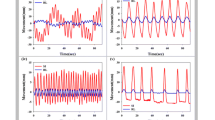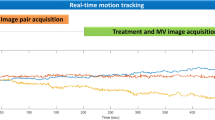Abstract
Background and purpose
To evaluate a novel four-dimensional (4D) ultrasound (US) tracking system for external beam radiotherapy of upper abdominal lesions under computer-controlled deep-inspiration breath-hold (DIBH).
Materials and methods
The tracking accuracy of the research 4D US system was evaluated using two motion phantoms programmed with sinusoidal and breathing patterns to simulate free breathing and DIBH. Clinical performance was evaluated with five healthy volunteers. US datasets were acquired in computer-controlled DIBH with varying angular scanning angles. Tracked structures were renal pelvis (spherical structure) and portal/liver vein branches (non-spherical structure). An external marker was attached to the surface of both phantoms and volunteers as a secondary object to be tracked by an infrared camera for comparison.
Results
Phantom measurements showed increased accuracy of US tracking with decreasing scanning range/increasing scanning frequency. The probability of lost tracking was higher for small scanning ranges (43.09% for 10° and 13.54% for 20°).The tracking success rates in healthy volunteers during DIBH were 93.24 and 89.86% for renal pelvis and portal vein branches, respectively. There was a strong correlation between marker motion and US tracking for the majority of analyzed breath-holds: 84.06 and 88.41% of renal pelvis target results and 82.26 and 91.94% of liver vein target results in anteroposterior and superoinferior directions, respectively; Pearson’s correlation coefficient was between 0.71 and 0.99.
Conclusion
The US system showed a good tracking performance in 4D motion phantoms. The tracking capability of surrogate structures for upper abdominal lesions in DIBH fulfills clinical requirements. Further investigation in a larger cohort of patients is underway.
Zusammenfassung
Hintergrund und Ziel
Evaluation eines neuen vierdimensionalen (4D) Ultraschall(US)-Tracking-Systems für die externe Strahlentherapie von Oberbauchläsionen unter computergesteuertem tiefem Atemanhalt (DIBH).
Material und Methoden
Die Tracking-Genauigkeit des 4D-US-Systems wurde mittels zweier Bewegungsphantome, die mit sinusförmigen und atmungsähnlichen Bewegungsmustern zur Simulation der freien Atmung und DIBH programmiert wurden, bestimmt. Die klinische Leistungsfähigkeit des Systems wurde an 5 gesunden Probanden untersucht. US-Datensätze wurden in computergesteuertem DIBH mit unterschiedlichen Scanwinkeln erfasst. Die getrackten Strukturen waren Nierenbecken (kugelförmige Struktur) und Portal-/Lebervenenzweige (nicht kugelförmige Struktur). Zum Vergleich wurde ein externer Marker als sekundäres, von einer Infrarotkamera getracktes Objekt auf der Oberfläche beider Phantome und Probanden angebracht.
Ergebnisse
Phantommessungen zeigten eine erhöhte Genauigkeit des US-Trackings, wenn der Scanbereich verkleinert wurde. Die Wahrscheinlichkeit für einen Verlust der zu trackenden Struktur war für kleine Scanbereiche höher (43,09 % für 10°; 13,54 % für 20°). Die Tracking-Erfolgsraten bei gesunden Probanden während DIBH waren 93,24 % und 89,86 % für Nierenbecken bzw. Pfortaderäste. Die Mehrheit der untersuchten Atemanhaltephasen wies eine starke Korrelation zwischen der Bewegung des Markers und dem US-Tracking auf: 84,06 und 88,41 % für Nierenbeckentargets und 82,26 und 91,94 % für Lebervenentargets jeweils in anteroposteriorer und superoinferiorer Richtung; der Pearson-Korrelationskoeffizient lag zwischen 0,71 und 0,99.
Schlussfolgerung
Das US-System zeigte eine gute Tracking-Leistung in 4D-Bewegungsphantomen. Die Tracking-Fähigkeit von Surrogat-Strukturen für Oberbauchläsionen in DIBH erfüllt die klinischen Anforderungen. Weitere Untersuchungen in einer größeren Patientengruppe sind im Gange.




Similar content being viewed by others
References
Scorsetti M, Clerici E, Comito T (2014) Stereotactic body radiation therapy for liver metastases. J Gastrointest Oncol 5(3):190–197. doi:10.3978/j.issn.2078-6891.2014.039
Kirkpatrick JP, Kelsey CR, Palta M, Cabrera AR, Salama JK, Patel P, Perez BA, Lee J, Yin F‑F (2014) Stereotactic body radiotherapy: a critical review for nonradiation oncologists. Cancer 120(7):942–954. doi:10.1002/cncr.28515
Boda-Heggemann J, Frauenfeld A, Weiss C, Simeonova A, Neumaier C, Siebenlist K, Attenberger U, Heußel CP, Schneider F, Wenz F, Lohr F (2014) Clinical outcome of hypofractionated breath-hold image-guided SABR of primary lung tumors and lung metastases. Radiat Oncol 9(1):1–9. doi:10.1186/1748-717X-9-10
EB-v G, Svd M, Hendry J, Buijsen J, Visser P, Fontanarosa D, Lachainey M, Lammering G, Verhaegen F (2012) Active breathing control in combination with ultrasound imaging: a feasibility study of image guidance in stereotactic body radiation therapy of liver lesions. Int J Radiat Oncol Biol Phys 85(4):1096–1102. doi:10.1016/j.ijrobp.2012.08.016
Shirato H, Suzuki K, Sharp GC, Fujita K, Onimaru R, Fujino M, Kato N, Osaka Y, Kinoshita R, Taguchi H, Onodera S, Miyasaka K (2006) Speed and amplitude of lung tumor motion precisely detected in four-dimensional setup and in real-time tumor-tracking radiotherapy. Int J Radiat Oncol Biol Phys 64(4):1229–1236
Harris EJ, Miller NR, Bamber JC, Symonds-Tayler JRN, Evans PM (2010) Speckle tracking in a phantom and feature-based tracking in liver in the presence of respiratory motion using 4D ultrasound. Phys Med Biol 55:3363–3380. doi:10.1088/0031-9155/55/12/007
Boda-Heggemann J, Walter C, Mai S, Dobler B, Dinter D, Wenz F, Lohr F (2006) Frameless stereotactic radiosurgery of a solitary liver metastasis using active breathing control and stereotactic ultrasound. Strahlenther Onkol 182:216–221
O’Shea T, Bamber J, Fontanarosa D, van der Meer S, Verhaegen F, Harris E (2016) Review of ultrasound image guidance in external beam radiotherapy part II: intra-fraction motion management and novel applications. Phys Med Biol 61(8):R90–R137. doi:10.1088/0031-9155/61/8/r90
Boda-Heggemann J, Dinter D, Weiss C, Frauenfeld A, Siebenlist K, Attenberger U, Ottstadt M, Schneider F, Hofheinz R‑D, Wenz F, Lohr F (2012) Hypofractionated image-guided breath-hold SABR (Stereotactic Ablative Body Radiotherapy) of liver metastases – clinical results. Radiat Oncol 7(1):92
Wong JW, Sharpe MB, Jaffray DA, Kini VR, Robertson JM, Stromberg JS, Martinez AA (1999) The use of active breathing control (ABC) to reduce margin for breathing motion. Int J Radiat Oncol Biol Phys 44(4):911–919
Boda-Heggemann J, Knopf A‑C, Simeonova-Chergou A, Wertz H, Stieler F, Jahnke A, Jahnke L, Fleckenstein J, Vogel L, Arns A, Blessing M, Wenz F, Lohr F (2016) Deep inspiration breath hold – based radiation therapy: a clinical review. Int J Radiat Oncol Biol Phys 94(3):478–492
Abbas H, Chang B, Chen ZJ (2014) Motion management in gastrointestinal cancers. J Gastrointest Oncol 5:223–235. doi:10.3978/j.issn.2078-6891.2014.028
Lachaine M, Falco T (2013) Intrafractional prostate motion management with the Clarity Autoscan system. Med Phys Int 1:72–80
Boda-Heggemann J, Fleckenstein J, Lohr F, Wertz H, Nachit M, Blessing M, Stsepankou D, Löb I, Küpper B, Kavanagh A, Hansen VN, Brada M, Wenz F, McNair H (2011) Multiple breath-hold CBCT for online image guided radiotherapy of lung tumors: simulation with a dynamic phantom and first patient data. Radiother Oncol 98(3):309–316. doi:10.1016/j.radonc.2011.01.019
Shimizu S, Shirato H, Xo B, Kagei K, Nishioka T, Hashimoto S, Tsuchiya K, Aoyama H, Miyasaka K (1999) Three-dimensional movement of a liver tumor detected by high-speed magnetic resonance imaging. Radiother Oncol 50:367–370
Park JC, Park SH, Kim JH, Yoon SM, Song SY, Liu Z, Song B, Kauweloa K, Webster MJ, Sandhu A, Mell LK, Jiang SB, Mundt AJ, Song WY (2012) Liver motion during cone beam computed tomography guided stereotactic body radiation therapy. Med Phys 39:6431. doi:10.1118/1.4754658
Hallman JL, Mori S, Sharp GC, Lu H‑M, Hong TS, Chen GTY (2012) A four-dimensional computed tomography analysis of multiorgan abdominal motion. Int J Radiat Oncol Biol Phys 83(1):435–441
Wong VYW, Tung SY, Ng AWY, Li FAS, Leung JOY (2010) Real-time monitoring and control on deep inspiration breath-hold for lung cancer radiotherapy – Combination of ABC and external marker tracking. Med Phys 37(9):4673–4683. doi:10.1118/1.3476463
Tanguturi SK, Lyatskaya Y, Chen Y, Catalano PJ, Chen MH, Yeo WP, Marques A, Truong L, Yeh M, Orlina L, Wong JS, Punglia RS, Bellon JR (2015) Prospective assessment of deep inspiration breath-hold using 3‑dimensional surface tracking for irradiation of left-sided breast cancer. Pract Radiat Oncol 5(6):358–365. doi:10.1016/j.prro.2015.06.002
Stieler F, Wenz F, Scherrer D, Bernhardt M, Lohr F (2012) Clinical evaluation of a commercial surface-imaging system for patient positioning in radiotherapy. Strahlenther Onkol 188(12):1080–1084. doi:10.1007/s00066-012-0244-7
Willoughby TR, Kupelian PA, Pouliot J, Shinohara K, Aubin M, Roach M, Skrumeda LL, Balter JM, Litzenberg DW, Hadley SW, Wei JT, Sandler HM (2006) Target localization and real-time tracking using the Calypso 4D localization system in patients with localized prostate cancer. Int J Radiat Oncol Biol Phys 65:528–534
Shirato H, Shimizu S, Kunieda T, Kitamura K, Herk MV, Kagei K, Nishioka T, Hashimoto S, Fujita K, Aoyama H, Tsuchiya K, Kudo K, Miyasaka K (2000) Physical aspects of a real-time tumor-tracking system for gated radiotherapy. Int J Radiat Oncol Biol Phys 48(4):1187–1195
Bell MAL, Byram BC, Harris EJ, Evans PM, Bamber JC (2012) In vivo liver tracking with a high volume rate 4D ultrasound scanner and a 2D matrix array probe. Phys Med Biol 57:1359–1374
Fayad H, Pan T, Clément J‑F, Visvikis D (2011) Technical note: Correlation of respiratory motion between external patient surface and internal anatomical landmarks. Med Phys 38:3157–3164
Author information
Authors and Affiliations
Corresponding author
Ethics declarations
Conflict of interest
D.S.K. Sihono, L. Vogel, C. Weiß, and J. Thölking declare that they have no competing interests. F. Lohr received research grants from Elekta and IBA, teaching honoria from Elekta and IBA, board honoria from C‑Rad, and works for the IBA advisory board. F. Wenz received research grant and teaching honoraria from Elekta, and works as consultant and for the advisory board of Elekta. J. Boda-Heggemann received a research grant, teaching honoraria, and travel expenses from Elekta. H. Wertz received a research grant and teaching honoraria from Elekta and IBA.
Additional information
Judit Boda-Heggemann and Hansjörg Wertz contributed equally to the manuscript.
Rights and permissions
About this article
Cite this article
Sihono, D.S.K., Vogel, L., Weiß, C. et al. A 4D ultrasound real-time tracking system for external beam radiotherapy of upper abdominal lesions under breath-hold. Strahlenther Onkol 193, 213–220 (2017). https://doi.org/10.1007/s00066-016-1076-7
Received:
Accepted:
Published:
Issue Date:
DOI: https://doi.org/10.1007/s00066-016-1076-7
Keywords
- Stereotactic body radiotherapy (SBRT)
- Ultrasound
- Radiotherapy, image-guided
- Intrafractional tracking
- Upper abdomen




